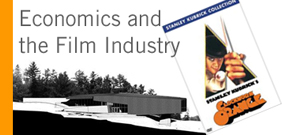
Chapter 3
Comparison with Building Industry
The parallels that exist between the artistic mediums of architecture and film are numerous. This section will explore how these two industries are related in terms of the method of procuring major projects and how the building industry generally and architecture specifically can learn from the film model. The film industry has historically been amenable to directors and their collaborators who seek to produce films that challenge traditional methods while appealing to a large audience within the conventional funding models. This type of progress is less common in the building industry where conservative attitudes prevail resulting in a relatively slow evolution of traditional design and technical innovation. It is proposed that the reason behind this lack of innovation is directly related to the structure of the building industry as compared with the film industry. One solution to potentially alleviating some resistance to innovation in the building industry is to adopt a hybrid model that incorporates some of mechanisms within the film industry that allow for creative freedom.
For the film and building industries, the scale of projects, measured in terms of time, financial costs and revenue are similar. This table outlines some of these comparables. The time involved in producing a $40m building or film is also similar from start to finish however the cash flow and pace of construction/ production are very different. Where a $40m building may be under construction for 30 months having a cash flow averaging $750k to $1m per month a film with a similar budget may be shot over a few months with an average monthly cash-flow approaching $10m.
Another primary difference is the number of key contributors in each profession who have creative impute at various phases of the process. The following figure 3.1 contrasts the traditional make-up of film making professionals with professions typically involved in a large-scale building project. This list is by no means exhaustive. In the case of both films and buildings, there are many specialists who would be involved in specific project were necessary however it is difficult to establish the counterpart profession.Figure 3.1 (more detailed figure- click here)
Building Industry vs. Film Industry Roles
Writer Owner/Program writer
Director Architect/Project Manager
Producer Client/Developer
Investor/Producer’s Representative Bank/Lending institution
Production Designer Interior Designer/Design architect
Cinematographer
Music composer
Actors/cast Sub consultants/Tradesmen
Crew Contractor
Editor
Studio/Distributor REIT/Client
Marketing
Audience Purchaser
In contrast, the building industry operates on a very different model. Professionals responsible for creative impute and those who finance and capitalize off the success of the project are almost never in the same people. As a result there is little financial incentive for the creative architect and his collaborators to conceive of a scheme that amongst other considerations is financially viable, and individuals involved with financing of the project have little incentive from professional peers or there buyers to commission innovative buildings beyond what is most profitable.
In his book “Freakonomics” Steven Levitt explains the important role of incentives in our society and specifically how architects, developers and other experts must have the right incentives in place if we expect them to act in the best interest of society or an individual retaining their services.
… experts are human, and humans respond to incentives. How any given expert treats you, therefore, will depend on how that expert’s incentives are set up. Sometimes his incentives may work in your favor… But in a different case, an expert’s incentives may work against you.
By envisioning an organization in the building industry where the commitment to quality, creative innovation and economic returns are weighted equally and professionals from each discipline work together and share in the profits of the successful project, it is anticipated that the incentives that are in the best interest of society would be aligned with economic prosperity of those involved.
Vision of the Collaborative Building Studio
A collaborative design studio working with a variety of free-lance professionals to provide a broad range of talents for clients seeking comprehensive graphic, architectural and product design services to establish branding and image definition.
In an increasingly service based economy, where technology and trends shift at an alarmingly high rate, companies increasingly need a comprehensive service to coordinate their evolving images. A full range of cohesive design services allows this type of office to tailor to clients needs, in order to offer them a competitive edge in a market where strong corporate identity dictates success. To keep the work fresh, innovative and targeted, the studio works with a network of design professionals and tailor each project team to provide a range of services such as architecture, exhibitions, corporate identity, interior design, and graphic design.
Inherent in this vision is the framework of the film industry approach, where individuals offer specific talents to the process coordinated under one creative director who carries the project through to completion. It is anticipated that this model would not only better utilize professionals within the building industry but encourage a culture of design excellence through extending authorship of the final product to all of the key individuals involved engendering an sense of pride and accomplishment in the final outcome.Freakonomics pg 7
Economics and the Film Industry • Final Assignment - Arch 646 • Tavis McAuley